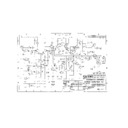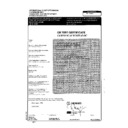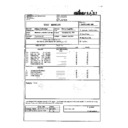Harman Kardon SIGNATURE 1.3 (serv.man5) User Manual / Operation Manual ▷ View online
Installation and Connections
6
Signature 1.3
Cable with a diameter of 1.0mm
2
may be used for short
runs of less than 4 meters. We do not recommend the use
of cables with a smaller diameter due to the power loss
and degradation in performance that will occur.
of cables with a smaller diameter due to the power loss
and degradation in performance that will occur.
Cables run inside walls should have the appropriate
markings to indicate listing with the appropriate safety
agency standards that may be required in your area.
Questions about running cables inside walls should be
referred to your installer or a licensed electrical contractor
who is familiar with the applicable building or electrical
codes in your area.
markings to indicate listing with the appropriate safety
agency standards that may be required in your area.
Questions about running cables inside walls should be
referred to your installer or a licensed electrical contractor
who is familiar with the applicable building or electrical
codes in your area.
Connections to Speakers
The final step of the installation process is to connect the
amplifier to your speakers using high-quality cable. A pair
of binding posts is provided for each channel output.
amplifier to your speakers using high-quality cable. A pair
of binding posts is provided for each channel output.
Note that one conductor of the speaker cable will have no
markings or an indication of “
markings or an indication of “
–
” for negative polarity, and
the other will have a red line, brand-name markings, a
colored thread or some other positive-polarity indication.
colored thread or some other positive-polarity indication.
The wire with the positive indication should be connected
to the red terminals on both the 1.3 and your speakers.
The negative wire should be connected to the black
terminal on the 1.3 and the speakers.
to the red terminals on both the 1.3 and your speakers.
The negative wire should be connected to the black
terminal on the 1.3 and the speakers.
If bare wire is used for connections, strip approximately
3
⁄
4
˝
(20 mm) of insulation from the end of each wire and
carefully twist the strands of each conductor together. Be
careful not to cut the individual strands or twist them off;
for optimal performance, all strands must be used.
careful not to cut the individual strands or twist them off;
for optimal performance, all strands must be used.
Next, loosen the knobs of the speaker output terminals far
enough so that the cap moves back on its threads past the
holes at the rear of the terminal. Making certain that you
observe polarity by connecting the negative (
enough so that the cap moves back on its threads past the
holes at the rear of the terminal. Making certain that you
observe polarity by connecting the negative (
–
) wire to
the black terminal and the positive (
+
) wire to the red
terminal, pass the exposed wire through the hole until the
wire is visible from the bottom end. Holding the wire in
place, twist the cap back so that the connection is secured.
Do not overtighten or use tools, as this may damage the
plastic terminal cap or break the delicate wire strands and
decrease system performance.
wire is visible from the bottom end. Holding the wire in
place, twist the cap back so that the connection is secured.
Do not overtighten or use tools, as this may damage the
plastic terminal cap or break the delicate wire strands and
decrease system performance.
Important Note: When making speaker wire connec-
tions, be certain that none of the strands from one lead
touch any other lead. This will cause a short circuit and
may damage your amplifier or speakers. Damage from
short circuits caused in this manner is not covered by the
product warranty.
tions, be certain that none of the strands from one lead
touch any other lead. This will cause a short circuit and
may damage your amplifier or speakers. Damage from
short circuits caused in this manner is not covered by the
product warranty.
Finally, run the cables to the speaker locations. It is highly
recommended that the length of cable connecting any pair
of speakers be identical. For example, make certain that the
cable length connecting left and right front or left and right
rear (surround) speakers is identical, even though one
speaker may be physically closer to the amplifier than the
other. Do not coil any excess cable, as this may become an
inductor that creates frequency response variations in your
system.
recommended that the length of cable connecting any pair
of speakers be identical. For example, make certain that the
cable length connecting left and right front or left and right
rear (surround) speakers is identical, even though one
speaker may be physically closer to the amplifier than the
other. Do not coil any excess cable, as this may become an
inductor that creates frequency response variations in your
system.
Connect the wires to the speakers, again being certain to
observe proper polarity. Remember to connect the
negative or black wire to the matching terminal on the
speaker. Similarly, the positive or red wire should be
connected to the like terminal on the speaker.
observe proper polarity. Remember to connect the
negative or black wire to the matching terminal on the
speaker. Similarly, the positive or red wire should be
connected to the like terminal on the speaker.
Note: While most speaker manufacturers adhere to an
industry standard of using black terminals for negative and
red ones for positive, some manufacturers may not adhere
to this configuration. To ensure properly phased
connections and optimal performance, consult the
identification plate on your speaker terminals, or the
speaker’s manual to verify polarity. If you do not know the
polarity of your speaker, ask your dealer or installer for
advice before proceeding, or consult the speaker’s
manufacturer.
industry standard of using black terminals for negative and
red ones for positive, some manufacturers may not adhere
to this configuration. To ensure properly phased
connections and optimal performance, consult the
identification plate on your speaker terminals, or the
speaker’s manual to verify polarity. If you do not know the
polarity of your speaker, ask your dealer or installer for
advice before proceeding, or consult the speaker’s
manufacturer.
Operation
7
Signature 1.3
The Signature 1.3 may be operated in either a manual or
automatic mode. If the unit is being used in standalone
operation you should follow the instructions below for
Manual Operation. When the 1.3 is connected to another
Signature Series product or to another compatible device,
follow the instructions for Automatic Operation.
automatic mode. If the unit is being used in standalone
operation you should follow the instructions below for
Manual Operation. When the 1.3 is connected to another
Signature Series product or to another compatible device,
follow the instructions for Automatic Operation.
Operation of the Signature Series 1.3 is simple. There are
no controls to adjust once the installation is complete.
no controls to adjust once the installation is complete.
Manual Operation
For conventional, standalone operation, first make all
connections to speakers and input sources as outlined on
the previous pages. Make certain that the front panel
connections to speakers and input sources as outlined on
the previous pages. Make certain that the front panel
Power Switch
1 is in the fully extended “off” position
and then connect the
AC Power Cord
£ to a wall-
mounted AC outlet with sufficient current capacity. Note
that the
that the
LED Indicator
3 will glow red.
Turn the unit on, press the front panel
Power Switch
1
until it is flush with the front panel. Once the switch is
turned on, the 1.3 will go into a brief warm-up mode, as
indicated by the
turned on, the 1.3 will go into a brief warm-up mode, as
indicated by the
LED Indicator
3 flashing green. This is
normal, and it protects your speakers from damage as the
amplifier stabilizes.
amplifier stabilizes.
When the 1.3 is fully ready for operation the LED
Indicator will go out and the
Indicator will go out and the
Power On Indicator
2 will
glow blue behind the word
S
IGNATURE
. At this point you
will begin to hear audio from the speakers connected to
the 1.3.
the 1.3.
You are now ready to enjoy the finest sonic performance
available. No further adjustments are needed, as all
volume controls and/or level adjustments are made at
your preamp controller or surround processor.
available. No further adjustments are needed, as all
volume controls and/or level adjustments are made at
your preamp controller or surround processor.
To turn the 1.3 off, press the
Power Switch
1 until it
protrudes from the front panel. The unit is in the “off”
position when the LED Indicator returns to a red color.
position when the LED Indicator returns to a red color.
Note: Always turn on the source components and
processor in your system first, and turn on your amplifier
last. This avoids the possibility of any turn-on pops or
transients from other equipment being amplified and sent
to your speakers, where they may cause damage. Always
start with a low volume level on your controller or
preamp to avoid damage to your speakers.
processor in your system first, and turn on your amplifier
last. This avoids the possibility of any turn-on pops or
transients from other equipment being amplified and sent
to your speakers, where they may cause damage. Always
start with a low volume level on your controller or
preamp to avoid damage to your speakers.
Automatic Operation
Before proceeding, make certain that the connection
between the 1.3 and 2.0 or 1.0 processor/tuner or other
trigger source has been properly made as outlined
previously. At this point the triggering unit should be
turned off.
between the 1.3 and 2.0 or 1.0 processor/tuner or other
trigger source has been properly made as outlined
previously. At this point the triggering unit should be
turned off.
With the
Power Switch
1 in the fully extended “off”
position, plug the
AC Power Cord
£ into a wall-
mounted AC outlet with sufficient current capacity. The
LED Indicator
3 will light up in a red color.
Press the
Power Switch
1 so that it is in the “on”
position and flush with the front panel. At this point the
LED Indicator
3 will turn amber, indicating that the 1.3
is in a Standby mode and ready to turn on when it
receives a signal from the Signature 2.0 or other device.
receives a signal from the Signature 2.0 or other device.
To activate the 1.3, turn on the Signature 2.0 or the other
device that is connected to the
device that is connected to the
Power Amp Trigger In
¢.
Once the trigger signal is received the 1.3 will go into a
brief warm-up mode, as indicated by the
brief warm-up mode, as indicated by the
LED Indicator
3 flashing green. This is normal, and it protects your
speakers from damage as the amplifier stabilizes.
speakers from damage as the amplifier stabilizes.
When the 1.3 is fully ready for operation the LED
Indicator will go out and the
Indicator will go out and the
Power On Indicator
2 will
glow blue behind the word
S
IGNATURE
. At this point you
will begin to hear audio from the speakers connected to
the 1.3.
the 1.3.
Once your system is turned on, you are ready to enjoy the
finest sonic performance available. There are no controls to
adjust. All volume and level adjustments are made by your
preamp, controller or surround processor.
finest sonic performance available. There are no controls to
adjust. All volume and level adjustments are made by your
preamp, controller or surround processor.
At the conclusion of your listening session, there is no need
to manually turn off the 1.3. When the 2.0 or other
triggering device is turned off, the 1.3 will return to the
Standby mode and the
to manually turn off the 1.3. When the 2.0 or other
triggering device is turned off, the 1.3 will return to the
Standby mode and the
LED Indicator
3 will turn amber.
Important Note: If you will not be using your audio
system for an extended period of time, such as during
a vacation, it is always a good idea to turn the unit off
using the power switch. This will prevent the automatic
turn-on circuits from accidentally turning the system on
during your absence.
system for an extended period of time, such as during
a vacation, it is always a good idea to turn the unit off
using the power switch. This will prevent the automatic
turn-on circuits from accidentally turning the system on
during your absence.
Service Information / T
roubleshooting
8
Signature 1.3
If your installation has followed the procedures in this
manual, you should enjoy many years of trouble-free
operation and high-quality listening enjoyment. The 1.3
does not contain any user-serviceable parts. If you suspect
a problem that may require service assistance, contact
your dealer, installer or an authorized Harman Kardon
service depot.
manual, you should enjoy many years of trouble-free
operation and high-quality listening enjoyment. The 1.3
does not contain any user-serviceable parts. If you suspect
a problem that may require service assistance, contact
your dealer, installer or an authorized Harman Kardon
service depot.
You may also contact Harman Kardon via the World Wide
Web at www.harmankardon.com
Web at www.harmankardon.com
It is important that any repairs be carried out only by an
authorized Harman Kardon service agent to ensure proper
service and preserve the protection of your Limited
Warranty. It is a good idea to keep your sales slip or
receipt in a safe place (along with this manual) so that it
will be available to verify the purchase date for warranty
claims.
authorized Harman Kardon service agent to ensure proper
service and preserve the protection of your Limited
Warranty. It is a good idea to keep your sales slip or
receipt in a safe place (along with this manual) so that it
will be available to verify the purchase date for warranty
claims.
Input/Output Protection
Under some conditions, such as a shorted speaker wire,
DC voltage on an input connection or thermal overload,
the amplifier will place itself in a “protect” mode to
prevent damage to the amplifier. When this happens, the
LED Power Indicator will flash and alternate between red
and amber.
DC voltage on an input connection or thermal overload,
the amplifier will place itself in a “protect” mode to
prevent damage to the amplifier. When this happens, the
LED Power Indicator will flash and alternate between red
and amber.
When this occurs, IMMEDIATELY turn off the unit using
the power switch and correct the problem. Then turn the
unit back on. If the unit continues to go into a protect
mode, contact your dealer or installer for assistance.
the power switch and correct the problem. Then turn the
unit back on. If the unit continues to go into a protect
mode, contact your dealer or installer for assistance.
Troubleshooting Chart
The items listed below are a brief guide to minor problems that may arise with audio equipment such as the 1.3. Before
taking a unit in for service, you should check to see if any of these hints solve the problem. If these solutions do not rectify
the problem or if the problem recurs, contact your dealer or an authorized Harman Kardon service depot for assistance.
taking a unit in for service, you should check to see if any of these hints solve the problem. If these solutions do not rectify
the problem or if the problem recurs, contact your dealer or an authorized Harman Kardon service depot for assistance.
PROBLEM
Amplifier will not turn on.
Amplifier turns on, but no audio from
one or more channels.
one or more channels.
Audio plays, then cuts off.
DIAGNOSIS
• Power Switch turned off.
(Power LED lights red)
• Remote trigger cable not
properly connected.
• Inputs not connected to
proper jack.
• Speakers not connected
properly.
• Improper settings or output
levels from processor or
controller.
controller.
• Amplifier shorted (LED
flashes amber and red).
TROUBLESHOOTING HINTS
• Turn on Power Switch.
• Verify connection of trigger cable
at both ends.
• Check input connections.
• Check speaker connections.
• Check the settings on your preamp,
processor or controller.
• Check speaker connections for
short circuit.
Power Output:
High-Current Capability:
Frequency Response:
Power Bandwidth:
THD/IMD:
Negative Feedback:
Input Impedance:
Input Sensitivity:
Remote Trigger Voltage:
Remote Trigger Impedance:
Dimensions (W x H x D):
Weight:
Power Requirements:
3 x 100 watts @ 8 ohms
20Hz – 20kHz, <0.03% THD, All Channels Driven
3 x 150 watts @ 4 ohms
20Hz – 20kHz, <0.03% THD, All Channels Driven
20Hz – 20kHz, <0.03% THD, All Channels Driven
3 x 150 watts @ 4 ohms
20Hz – 20kHz, <0.03% THD, All Channels Driven
± 100 Amps per channel
1Hz – 170kHz ± 3dB
1Hz – >100kHz
<0.03% at rated output
<25dB
33K ohms
1 volt for rated output
6 – 12 volts DC (tip of plug must be “positive” (+))
20K ohms
440 x 148 x 330 mm
17 1⁄4 x 5 1⁄2 x 13 inches
17 1⁄4 x 5 1⁄2 x 13 inches
22,7 kg
230VAC, 50Hz / 60Hz
500 watts
500 watts
All features and specifications are subject to change without notice.
Signature 1.3 Multichannel Amplifier Specifications
9
T
echnical Specifications










